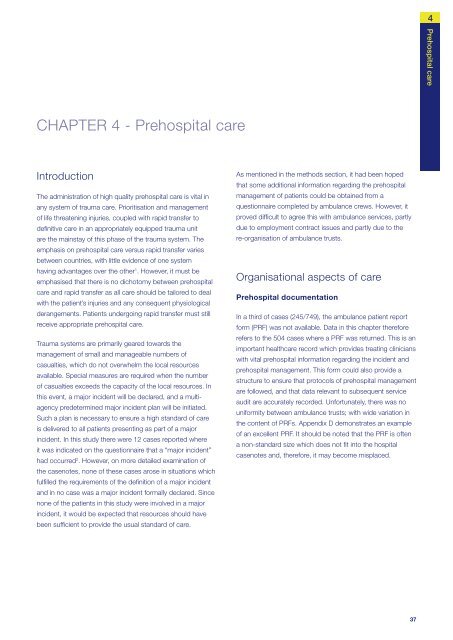NCEPOD: Trauma - Who Cares? - London Health Programmes
NCEPOD: Trauma - Who Cares? - London Health Programmes
NCEPOD: Trauma - Who Cares? - London Health Programmes
You also want an ePaper? Increase the reach of your titles
YUMPU automatically turns print PDFs into web optimized ePapers that Google loves.
4Prehospital careCHAPTER 4 - Prehospital careIntroductionThe administration of high quality prehospital care is vital inany system of trauma care. Prioritisation and managementof life threatening injuries, coupled with rapid transfer todefi nitive care in an appropriately equipped trauma unitare the mainstay of this phase of the trauma system. Theemphasis on prehospital care versus rapid transfer variesbetween countries, with little evidence of one systemhaving advantages over the other 1 . However, it must beemphasised that there is no dichotomy between prehospitalcare and rapid transfer as all care should be tailored to dealwith the patient’s injuries and any consequent physiologicalderangements. Patients undergoing rapid transfer must stillreceive appropriate prehospital care.<strong>Trauma</strong> systems are primarily geared towards themanagement of small and manageable numbers ofcasualties, which do not overwhelm the local resourcesavailable. Special measures are required when the numberof casualties exceeds the capacity of the local resources. Inthis event, a major incident will be declared, and a multiagencypredetermined major incident plan will be initiated.Such a plan is necessary to ensure a high standard of careis delivered to all patients presenting as part of a majorincident. In this study there were 12 cases reported whereit was indicated on the questionnaire that a “major incident”had occurred 2 . However, on more detailed examination ofthe casenotes, none of these cases arose in situations whichfulfi lled the requirements of the defi nition of a major incidentand in no case was a major incident formally declared. Sincenone of the patients in this study were involved in a majorincident, it would be expected that resources should havebeen suffi cient to provide the usual standard of care.As mentioned in the methods section, it had been hopedthat some additional information regarding the prehospitalmanagement of patients could be obtained from aquestionnaire completed by ambulance crews. However, itproved diffi cult to agree this with ambulance services, partlydue to employment contract issues and partly due to there-organisation of ambulance trusts.Organisational aspects of carePrehospital documentationIn a third of cases (245/749), the ambulance patient reportform (PRF) was not available. Data in this chapter thereforerefers to the 504 cases where a PRF was returned. This is animportant healthcare record which provides treating clinicianswith vital prehospital information regarding the incident andprehospital management. This form could also provide astructure to ensure that protocols of prehospital managementare followed, and that data relevant to subsequent serviceaudit are accurately recorded. Unfortunately, there was nouniformity between ambulance trusts; with wide variation inthe content of PRFs. Appendix D demonstrates an exampleof an excellent PRF. It should be noted that the PRF is oftena non-standard size which does not fi t into the hospitalcasenotes and, therefore, it may become misplaced.37
















